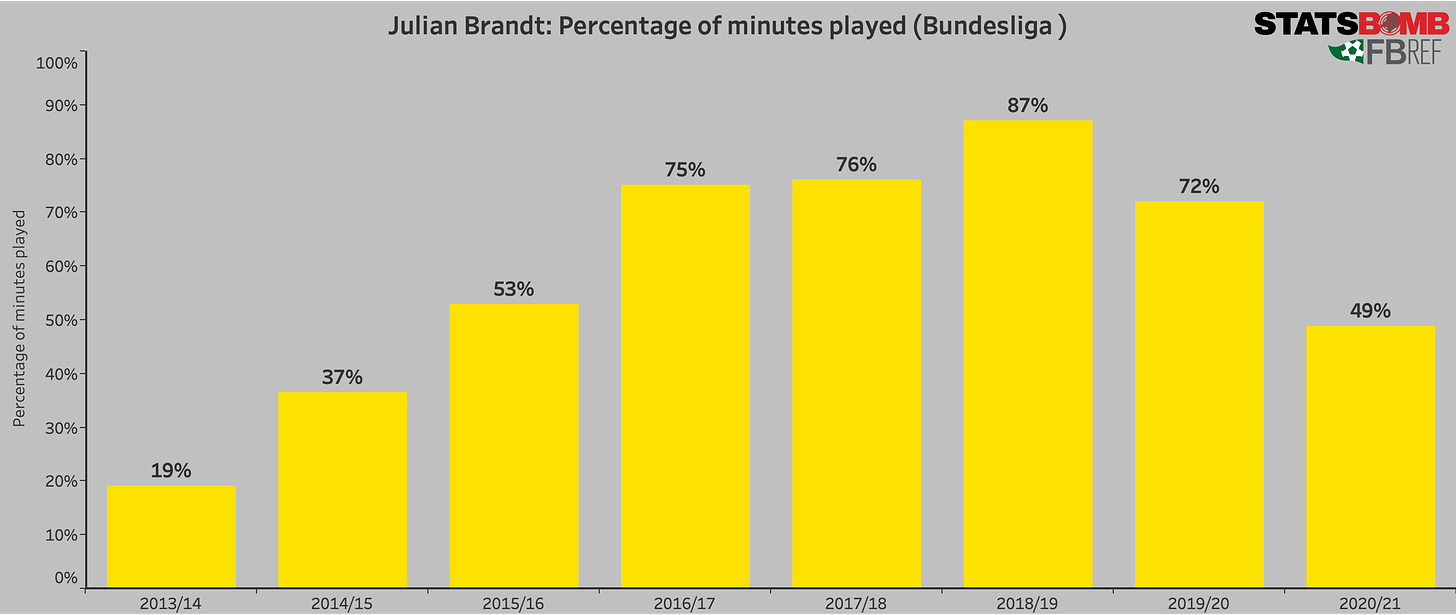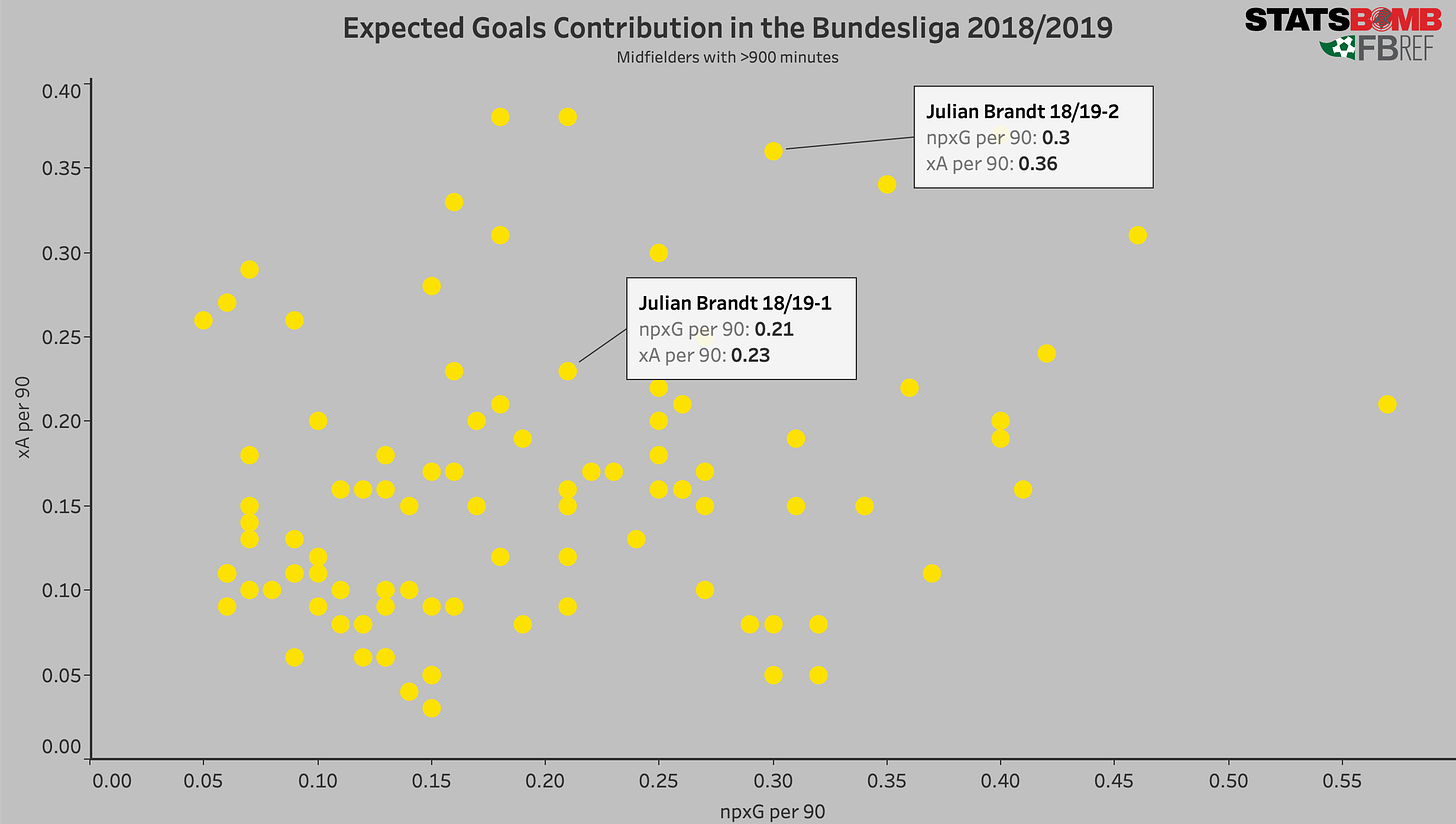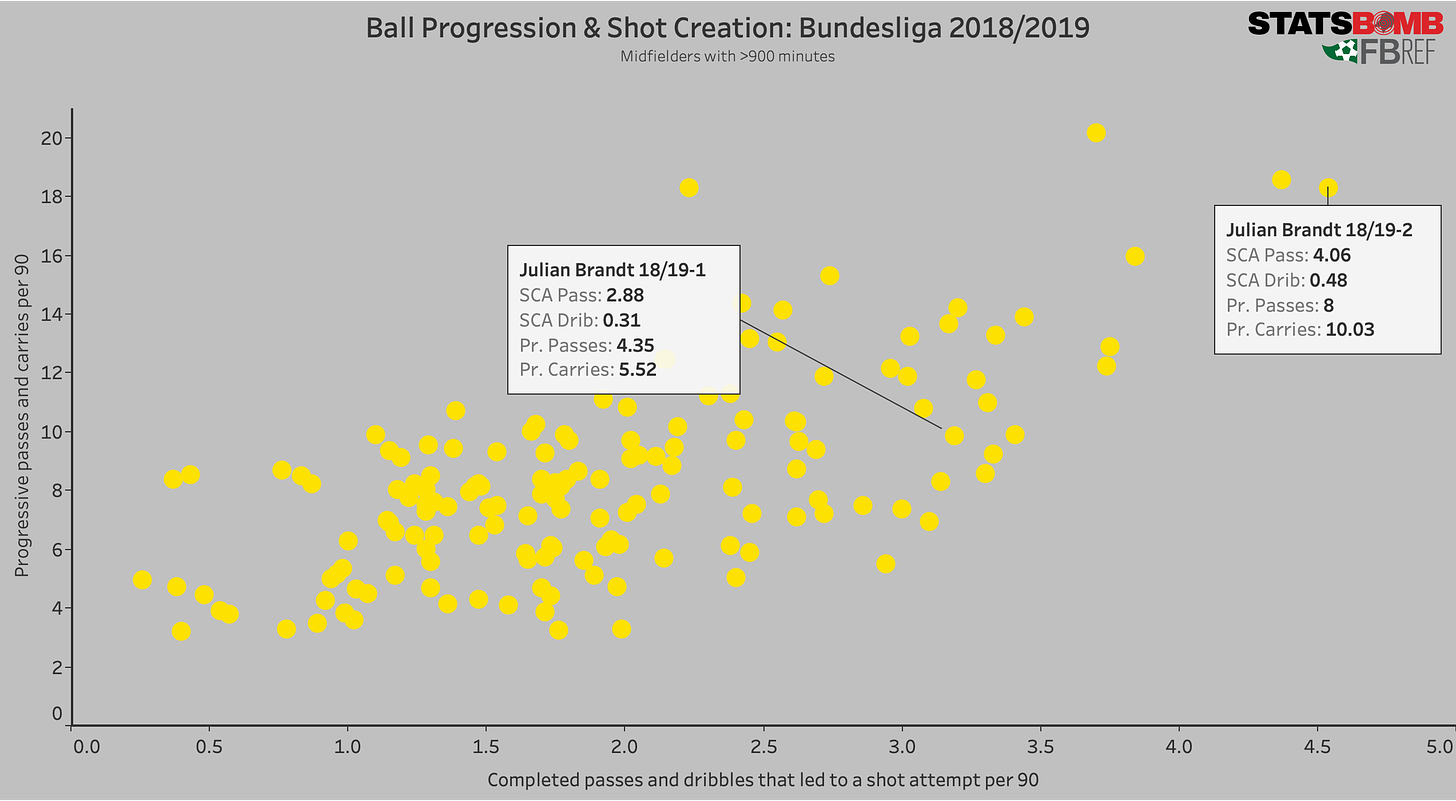Could this be the season of Julian Brandt?
“The first thing you notice about Julian Brandt on the pitch is that he’s different. […] But when the ball gets to him, everything seems to slow down for a moment, only to pick up the pace again in an instant as he passes or moves, like bullet time in The Matrix.” —Raphael Honigstein
Julian Brandt is perhaps still the most gifted German midfielder. When his talent is properly harnessed, he can be one of the most thrilling players in Europe, combining flair and creativity with elite dribbling and an ability to get into dangerous positions himself.
His career, however, has stagnated since his transfer from Leverkusen to Dortmund in 2019. While he had some very good performances in his first season and after all played 72% of all minutes in the Bundesliga, this number fell below 50 in his second year.
Before we dive deeper into his time in Dortmund, it’s helpful to understand Brandt’s trajectory at his former club Bayer Leverkusen …
Brandt made his Bundesliga debut in 2014 at the age of 17 and has been an integral part of Leverkusen’s starting lineup since then. While he was long recognized as one of Germany’s biggest talents, the 2018/19 season did make for a particular developmental milestone. When Leverkusen hired Peter Bosz in January 2019, one of his first decisions was to move Brandt from the wing to the centre. After solid but often inconsistent performances in previous years, the then 22-year-old flourished in this hybrid 8/10-role in Bosz’s 4-3-3.
A look at his numbers emphasizes this. Under Peter Bosz, Brandt was elite in almost every category for midfielders. He combined outstanding progression of the ball with outstanding creation numbers and even great goalscoring numbers at the same time. In other words, he did almost everything and with almost 20 touches more per game, he was clearly more involved in Leverkusen’s play.
While his increase in progression numbers can be explained due to his deeper and more central role as well as Peter Bosz’s possession-oriented tactics, his offensive output was particularly impressive. Overall, he averaged 0.66 non-penalty Expected Goals (npxG) and Expected Assists (xA) — by far the highest number of his career.
The following plot distinguishes between Brandt-1, i.e., his numbers in the first half of the season (c. 13 x 90s played) and Brandt-2, i.e., his numbers in the second half of the season (c. 17 x 90s played).
To double down on his progression and creation, here’s another illustration of how good he has been that second half of the season.
Things look similar for deep progressions (>9 per 90), i.e., passes and carries into the final third, as well as for his elite dribbling (3.3 successful dribbles per 90!). His dribbling ability combined with an inclination to do so in midfield areas makes him extremely dangerous in transition and when the opposition is looking to press high up the field.
Overall, Brandt is a very complete and extremely proficient midfielder who can do everything with the ball. He can dribble and escape from tight pressing situations, he’s a decent passer, he always seeks the direct path to the goal, he has a good feeling for space, and also a good understanding of tactical interrelationships.1 While none of this came out of the blue, this central role as some sort of transition player gave him more responsibility and allowed him to show even more of his abilities.
If a player has superior attacking abilities, it makes sense to get him involved as often as possible. You get the ball more often as an 8 than as a 10 or on the wing. More Brandt may mean better Brandt.—Martin Rafelt
In Dortmund, however, Brandt could never really follow on from his good performances at Leverkusen. Part of the reason was Lucien Favre’s tactics in Dortmund and the way he used Brandt. In the beginning, he deployed a 4-2-3-1 formation with Marco Reus as the attacking midfielder. Therefore, Brandt often switched to the wings which led to a somewhat bumpy start for him.
Brandt had his best performances around December 2019 when Lucien Favre switched to a 3-4-3 after the 1-3 defeat in Barcelona. In the new system, Brandt took one of the two central positions in midfield and acted deeper compared to Leverkusen. Consequently, he progressed the ball a lot and played even more passes into the final third. Even though he could not repeat his offensive output under Bosz, Brandt still managed to assist more than four shots per 90. If you isolate his numbers during this period, you come relatively close to his Leverkusen numbers in many aspects.
To cut a long story short: Overall, Brandt has had a disappointing in Dortmund so far. With that being said, he has shown how good he can be – both at Dortmund and Leverkusen. Here are four reasons why I think we may see the better version of him again this season.
1. New system
At Salzburg, Dortmund’s new coach Marco Rose implemented a very pressing-intense 4-3-1-2. Based on his past performances, playing as one of the 8s would likely suit him well.
2. New coach
Apart from the system, Rose and Maric have shown how well they can deal with polyvalent players and maximize their strengths. A good example of that is Jonas Hofmann at Gladbach who was used in a variety of positions in midfield and upfront. He has taken one of the most impressive developments of all Gladbach players over the last two seasons.
Brandt can play multiple positions, too. To some extent, it’s less about which position he ultimately plays but more about how he is supposed to interpret this position and how he is involved in the play. Perhaps, it could also be a confidence question. Peter Bosz trusted Brandt unconditionally and communicated that very openly. Whether or not that was a cause for his performance can be discussed but it certainly didn’t harm.
3. Dortmund needs a player like Brandt
For years, it has been one of Dortmund’s weaknesses to break deep-lying defenses and progress the ball into dangerous areas. Especially in the first half of last season, Dortmund’s play was very dependent on Raphael Guerreiro. Over the course of the season, he played more than nine progressive passes per 90, three more than the second-best Dortmund player Jadon Sancho followed by Thomas Meunier. Despite his bad season, Brandt was still Dortmund’s central midfielder who played the most progressive passes.
4. If not now, when?
Lastly, at 25, Brandt is in the prime of his career. There is so much untapped potential that has only scratched the surface. In addition, it’s probably not an exaggeration to say that this might be the decisive season of whether he will stay in Dortmund long-term or not. In this respect, it may even be to his advantage that he wasn’t part of Germany’s EURO 2020 squad which allowed him to participate in the entire pre-season.
Let’s assume that much of this turns out to be true … What exactly can we expect from Brandt?
Based on his stats over the last four seasons, Brandt averages 0.22 npxG per 90 and 0.24 xA per 90 in a variety of positions, largely as a winger. If we assume that he will be mostly used as an 8 in Rose’s system, we can pay particular attention to his stats in this position even though the sample size is limited.2
From there, we would usually go with the weighted average, but I believe it makes sense to use the “normal” average as Brandt’s roles in Dortmund and Leverkusen differed. While Brandt played as an 8/10 in Leverkusen, he played as a 6/8 in Dortmund. In a 4-3-1-2 he would probably play as a classic 8 which would be a mixture of both.
Say Rose and Maric like and value Brandt’s abilities and find a way to integrate him into their system, we could increase both numbers by 0.02. Factor in that he is entering his prime and has had an entire pre-season but also his COVID-infection, we can increase them by another 0.01, ending up with 0.24 npxG and 0.31 xA.
If we take into consideration that Leverkusen’s system was very much focused on Brandt as the one central focal point, we might reduce both numbers by 0.02 again to 0.22 and 0.29 respectively. He was arguably the best player that season in Leverkusen – in Dortmund he is just one of many.3
Now there are a few other factors at play. We have less than one season of data of Brandt playing in this position. He has only played around 16% (2279/14313) of all minutes as a CM over the last four seasons. Also, his output is heavily influenced by his time in Leverkusen and maybe that was just an outlier. Maybe this increases our risk assessment, and we could drop our expectations a little bit more.
However, if we would stick with our numbers, he would accumulate around 7.5 npxG and 10 xA over the course of an entire season. Given that he is currently out with COVID, the competition in Dortmund’s midfield and the fact that Rose will rotate due to UCL and cup matches, let’s assume he will play 75% of all minutes (25.5 x 90s). Based on that, he would end up with 7.4 xA and 5.6 npxG.
I think it’s a relatively conservative estimation but would still make Brandt one of the best midfielders in the Bundesliga. In addition, his overall contribution of 0.51 per 90 would make up for much of what is gone with Jadon Sancho (0.58).
In Germany, people often talk about the lack of creative players who can dribble and create some sort of surprising moments. If you could draw a player like that, Brandt would arguably tick many boxes. He has such a unique skillset that it’s almost a shame he hasn’t consistently shown his potential on the biggest stage.
With all these positive words being said, the competition in Dortmund has not become worse either and it’s by no means said and done that Brandt even becomes a starter. His Covid infection came at the worst time, too. Nevertheless, if he can even come close to his best performances at Leverkusen, it’s not crazy thinking he’ll be on the team of the season and become an integral part of Germany’s 2022 World Cup squad. If he could also improve defensively, there’s not much more you could possibly want from a player with that broad and deep set of talents.
His interviews after matches are (sometimes) quite interesting as he is often very accurate and relatively detailed in his judgment only a few minutes after the match.
Only includes matches in which Brandt started as CM. Especially in Dortmund, he sometimes switched positions mid-game.
You might argue that he has better teammates in Dortmund which is fair point. This might be a reason to increase the assumptions once more.







